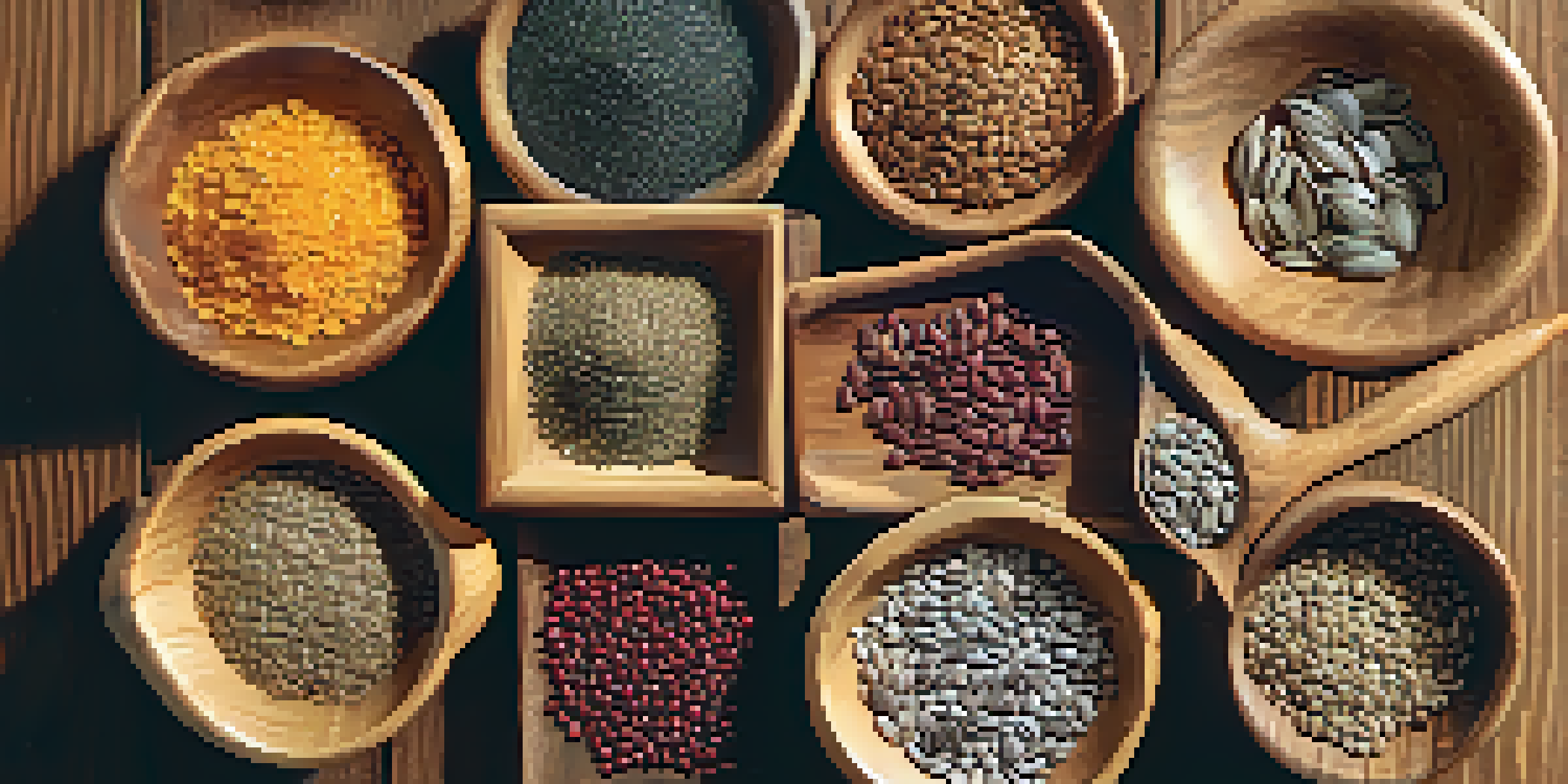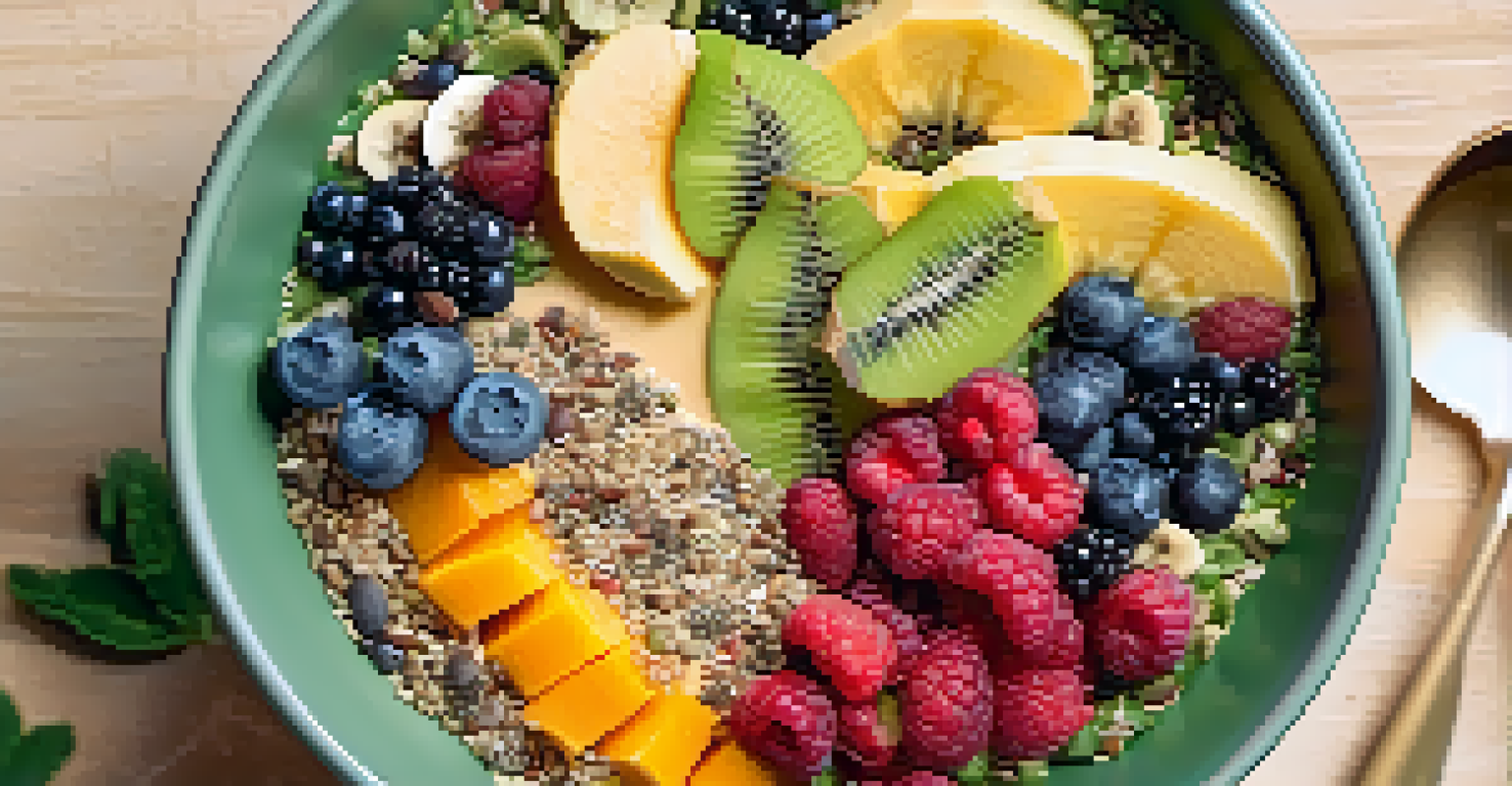Seeds: A Vital Component of Raw Food Preparation

Understanding the Role of Seeds in Raw Foods
Seeds are tiny nutritional powerhouses that play a crucial role in raw food preparation. They are packed with essential nutrients, healthy fats, and protein, making them a staple ingredient in many raw recipes. By incorporating seeds into your meals, you're not only enhancing flavor but also boosting the overall nutritional value of your diet.
Let food be thy medicine and medicine be thy food.
These little gems are often overlooked, yet they provide a variety of textures and tastes that can elevate any dish. From crunchy sunflower seeds to creamy chia seeds, their versatility makes them an essential ingredient in smoothies, salads, and snacks alike. Understanding how to use seeds can transform your raw food experience.
Moreover, seeds are incredibly easy to incorporate into your daily meals. Whether sprinkled on top of a salad or blended into a smoothie, they add a nutritional punch without complicating your preparation process. This simplicity allows anyone, regardless of culinary skills, to enjoy the benefits of raw food.
Nutritional Benefits of Different Seeds
Each type of seed offers unique health benefits that contribute to a balanced raw food diet. For example, chia seeds are rich in omega-3 fatty acids, which are essential for heart health. Meanwhile, flaxseeds are known for their high fiber content, promoting digestive health and helping you feel full longer.

Pumpkin seeds, or pepitas, are packed with magnesium and zinc, supporting immune function and overall wellness. Sunflower seeds provide vitamin E, a powerful antioxidant that helps protect your cells from damage. By diversifying the seeds you use, you can reap a wide range of health benefits.
Seeds Boost Nutritional Value
Incorporating a variety of seeds into your meals enhances flavor and significantly increases the overall nutritional benefits of your diet.
Including a variety of seeds in your meals not only enhances nutritional value but also keeps your diet interesting. Mixing different seeds can add flavor and texture, making healthy eating more enjoyable. It's an easy way to ensure you're getting a broad spectrum of nutrients.
How to Incorporate Seeds into Your Diet
Incorporating seeds into your diet can be both fun and simple. Start by adding a tablespoon of your favorite seeds to your morning smoothie or yogurt for a nutritious boost. You can also sprinkle them on salads, soups, or stir-fries to enhance flavor and texture.
The food you eat can either be the safest and most powerful form of medicine or the slowest form of poison.
Another great way to enjoy seeds is by creating seed-based snacks. Consider making energy balls with nut butter, oats, and a mix of seeds for a satisfying treat. These snacks are not only delicious but also packed with energy, making them perfect for on-the-go munching.
Don't forget about baking! Seeds can be a fantastic addition to raw bars, cookies, or crackers. Experimenting with different recipes will help you discover new ways to enjoy the benefits of seeds while satisfying your taste buds.
Soaking and Sprouting Seeds for Maximum Nutrition
Soaking and sprouting seeds can enhance their nutritional profile and digestibility. Soaking seeds overnight can help activate enzymes and increase their nutrient availability. This simple process can make a significant difference in how your body absorbs these nutrients.
Sprouting seeds takes this process a step further, encouraging them to germinate. Sprouted seeds are even richer in vitamins and minerals than their unsprouted counterparts. They can be added to salads, sandwiches, or enjoyed on their own as a crunchy snack.
Soaking Enhances Nutrient Absorption
Soaking and sprouting seeds can improve their digestibility and nutritional profile, making it easier for your body to absorb essential nutrients.
Both soaking and sprouting are easy methods to elevate your raw food preparation. With just a little time and effort, you can unlock the full potential of seeds, making them even more beneficial for your health.
Unique Recipes Featuring Seeds in Raw Food
Exploring recipes that highlight seeds can be a delightful culinary adventure. For instance, you can whip up a delicious raw energy bar using dates, nuts, and a mix of seeds. This snack not only satisfies your sweet tooth but also provides sustained energy throughout the day.
Another great option is a seed-based pesto, made with sunflower seeds, fresh basil, garlic, and olive oil. This vibrant sauce can elevate pasta dishes or serve as a dip for veggies. It's a flavorful way to incorporate more seeds into your meals and impress your friends.
Don't forget about seed crackers! By blending seeds with spices and water, you can create a crispy, nutritious snack. They pair wonderfully with guacamole or hummus, making them a perfect addition to any raw food platter.
Choosing the Right Seeds for Your Needs
With so many varieties of seeds available, it’s important to choose the ones that align with your health goals. If you’re looking for protein, consider hemp seeds, which are also rich in omega-6 and omega-3 fatty acids. For those seeking a fiber boost, chia and flaxseeds are excellent choices.
If you're interested in enhancing your heart health, pumpkin seeds are a great option, while sunflower seeds can offer vitamin E and selenium benefits. Understanding your nutritional needs will help you select the right seeds to complement your raw food diet.
Diverse Recipes with Seeds
Exploring unique recipes featuring seeds, such as energy bars and seed-based pesto, can make healthy eating enjoyable and exciting.
Ultimately, experimenting with different seeds can lead to discovering new favorites. Don’t hesitate to explore organic or specialty seeds that may not be as common. Each type of seed has its own unique flavor and texture, adding diversity to your meals.
Storage Tips for Fresh and Nutritious Seeds
Proper storage of seeds is essential to maintain their freshness and nutritional value. Seeds should be kept in an airtight container in a cool, dark place to prevent them from going rancid. This simple step can extend their shelf life significantly, allowing you to enjoy them for longer.
For seeds that are particularly prone to spoilage, like flaxseeds and chia seeds, storing them in the refrigerator can be a wise choice. This helps to preserve their omega-3 fatty acids and keeps them fresh for an extended period. Just remember to label your containers, so you know what you have on hand.

Regularly checking the freshness of your seeds is also important. If they no longer smell nutty or taste pleasant, it's time to replace them. Keeping your seeds fresh ensures that you're getting the most nutritional benefits from your raw food preparations.